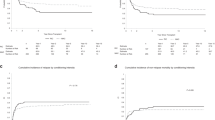Abstract
Secondary acute myeloid leukemia (s-AML) and secondary myelodysplastic syndrome (s-MDS) probably represent the worst possible long-term complications of cancer therapy in patients originally cured of their primary malignancy. The frequency and type of s-AML and s-MDS are reviewed for patients treated with standard and/or high-dose chemotherapy for Hodgkin's disease, non-Hodgkin's lymphoma (NHL), and breast or testicular cancer. Patients treated for Hodgkin's disease, have a 20- to 40-fold increased risk of developing s-AML, this risk increasing with the number of mechlorethamine-containing cycles given as well as following splenectomy and in patients more than 40–50 years of age. Generally, patients with NHL, breast or testicular cancer experience a lower, 2- to 15-fold, risk of developing s-AML. Epipodophyllotoxins appear to be the most important factor for s-AML in patients treated for testicular cancer. Doses of 2g/m2 or more are associated with an increased risk of s-AML and, with these high doses, a cumulative incidence of 2%–3% at 5 years is observed. Adjuvant cyclophosphomide, methobrexate, 5-Fu therapy in breast cancer patients does not appear to increase risk significantly as compared to the general population. The extent of the leukemogenic potential of anthracyclines remains to be defined. NHL patients receiving mechlorethamine, prednimustine or long-term maintenance therapy are also at an increased risk of s-AML. A considerably increased risk of developing AML, with a cumulative incidence of approximately 9% at 5 years, has been observed following allogenic bone marrow transplantation (ABMT) or peripheral stem cell transplantation (PBSCT) in patients with NHL. It is likely that the increased risk of s-AML/s-MDS following high-dose chemotherapy with ABMT or PBSCT is related to prior treatment rather than to high-dose chemotherapy itself. However, this issue remains to be conclusively addressed. s-AML or s-MDS rarely develops after allogenic bone marrow transplantation. s-AML and s-MDS increasingly represent a problem in modern cancer therapy because of better treatment strategies, which result in improved cure rates. Patients who receive chemotherapy must be informed about the potential risk of developing s-AML or s-MDS. Future studies should include a follow-up long enough to record the occurrence of all s-AML/s-MDS and all potential influencing factors reliably. These data would enable risk factors to be defined and risk/benefit analyses to be carried out, allowing the correct assessment of current and future therapy strategies.
Similar content being viewed by others
Author information
Authors and Affiliations
Additional information
Received: 22 July 1997 / Accepted: 27 November 1997
Rights and permissions
About this article
Cite this article
Kollmannsberger, C., Hartmann, J., Kanz, L. et al. Risk of secondary myeloid leukemia and myelodysplastic syndrome following standard-dose chemotherapy or high-dose chemotherapy with stem cell support in patients with potentially curable malignancies. J Cancer Res Clin Oncol 124, 207–214 (1998). https://doi.org/10.1007/s004320050156
Issue Date:
DOI: https://doi.org/10.1007/s004320050156




